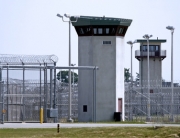San Mateo County Jail
Have you ever wondered how an inmate is booked into a jail? As bail bondsmen, clients and others often want to know the inner workings of the jail. Here is an inside look at the process, a “what happens behind closed doors” if you will, at the San Mateo County Brendon P. Maguire Correctional Facility, named after the San Mateo County sheriff who helped found it. The MCF opened in 1994. It is six stories tall and its top five floors are used to house inmates. Its intake and administration areas are on the ground floor.
No less than 18,000 inmates are booked into Maguire each year. Most of those incarcerated here are either awaiting their trial or in the process of it. Several more are also awaiting transportation to another agency if they have already been sentenced to do time in a state or county facility.
According to an official MCF mission statement this jail serves the community by assisting the courts, law enforcement agencies, and inmates and their families by offering a safe and secure environment. It also helps to ensure that defendants will appear in court and complete their jail sentences.
The Maguire Correctional Facility provides for its inmates’ medical, nutritional, hygienic, legal and spiritual needs. They also have several services that are designed to give inmates an opportunity to improve their lives, both during and after their incarceration, in an attempt to reduce recidivism.
Jail Arrival
An arrestee’s incarceration begins when he is bused into the MCF’s Vehicle Sally Port, which looks like a huge gray underground parking garage. This is the entry point in to the prison for arrestees escorted by police (it is also a transport and pick up point). But in this parking structure there is no exit ramp. The doors are electronically operated and security is maintained via a visual monitoring network that is linked to a Central Control Room.
The inmates are then taken, in handcuffs, to the pre-booking area to wait while their police paperwork is completed. If they are suspected of being under the influence, they will be given breathalyzer and alcohol blood tests. This process takes about 30 minutes.
Booking & Inmate Search
Next, in the Intake Section, the actual booking process begins. Their personal information is entered into a computer system and they are assigned a county ID number or, in the case of return visitors, their number is located. During intake, they are also given a jail number and housing assignment, they undergo a medical interview, and have their personal property inventoried and sealed in a bag (more on all this, later on). The last steps in this process are getting a photo taken and being fingerprinted.
But first, it’s on to the Search Cell: All of the inmates searched for both their own and staff safety, to make sure nobody is carrying any concealed weapons or contraband. There are two types of searches. One is the simple pat down of hands over clothing. The second is the strip search. Contrary to what you see in the movies, the strip search requires a supervisor’s written approval and is mostly performed on parolees, self-surrenders and “weekenders”.
Mental & Medical Reviews
The Department of Correctional Health services gives every new Maguire inmate a medical interview to find out what medication, if any, they are taking and their physical condition. They also receive a mental health interview to determine their state of mind, and whether or not they are a danger to themselves or others. Physical and mental interviews also play a key role in helping to determine where they should be housed during their stay.
Inmate Identification & Classification
Mug shots are taken of each prisoner to document his appearance, as well as any distinguishing marks, scars or tattoos. These photos are printed up as “movement cards” that will accompany the inmate to his eventual housing. Last, an ID wristband, much like the kind used in hospitals, is placed on his wrist.
Inmates are fingerprinted in another section, using state-of-the-art methods that don’t require ink. The fingerprints are then scanned into a database in case they are needed for future reference. Once this has been done, the inmates are placed in Holding Cells. These cells are a temporary location, but they help keep the arrestees secure and separated during the booking process. They are very much like waiting rooms, equipped with telephones and toilets.
Some of the more low risk arrestees, like those brought in on DUI charges, may be released on their "own recognizance," known as "OR". This means that they could end up being freed on the promise that they will return to court, without having to pay bail. The inmates are interviewed to determine if they qualify for OR, or need to be cited. It is also a first evaluation of their classification status.
The MCF uses a specific Classification Method for several reasons: to determine the inmate’s housing assignment; ensure his safety; and to give him a coded level of incarceration (sentenced or un-sentenced, security risk etc). He is also classified by physical attributes like height and ethnicity.
If an inmate is to be imprisoned, he is sent to Dress In. In this section, he learns where he will finally be housed. All his personal clothing is taken, sorted and then put in Maguire’s secure Property Storage Unit. There, it is hung in blue plastic bags on an “automated property bag retrieval system” which is much like the clothing conveyor belts found in dry cleaning stores. The inmate is given an orange jumpsuit to wear so that he can be easily identified and, just like a rank and file military uniform, because it make him equal to every other inmate.
Housing Pods, ie Jail Cells
Inmates live in General Housing Pods, which are actually two stories tall. They look like grim Spartan college dorm rooms in that they are small, two person cells surrounding a gray-carpeted day room. There are 24 cells on each level and the Pods are supervised by a deputy in an open station at the center. Assigning an inmate to a cell once again depends on his classification, the nature of the offense, criminal history, physical size and gang affiliation.
Inside each cell, two bunk beds can be found bolted into the wall, along with a writing desk, shelf, plastic chair and a stainless steel toilet that offers no privacy. Twice daily, prisoners must go through a body count and inspection. This ensures that they’re all accounted for, jail rules are followed, they and the facility remain safe and secure, and that they are keeping themselves and their cell clean. Inmates must line up with their backs against a cell wall with their arms extended for shorter inspections, which can be as frequent every two hours.
Central Control, a hi-tech monitor system that could be considered the brain of the facility, controls all of the doors and systems. It is also a communication center that is manned around the clock, keeping an eye on daily prison activities and serving as a command post during emergencies.
Specialized Maguire Programs
During the time that inmates must serve their sentence, a variety of programs are offered to them. In addition to medical and mental care, MCF Correctional Health Services provide dental care and drug/alcohol AA recovery meetings and domestic violence groups. They also have access to religious services, a law library, AIDS Awareness and parenting courses, and an Office of Education where they can get a GED, along with business links between the MCF population and community organizations.
The Maguire facility offers some inmates a chance to earn money by working in its industrial sized kitchen (which outputs 2700 meals a day) and laundry room (laundry is exchanged once a week), under correctional supervision. They can also spend money at the prison commissary. There, inmates charge items on their MCF accounts to buy food, personal hygiene items, writing/post materials, over the counter meds and phone cards.
Visiting & Release
Visiting hours vary, excluding Mondays. A day care center with toys, books, crayons and snacks was created free of charge by the Service League of San Mateo for those inmates who are visited by their children.
When an inmate has served his time, or bail has been posted, and he is ready for release, he is taken to the Men’s Dress Out Section where his things are returned to him. Once his paperwork is complete, he is free to go.
We know that prison changes some inmates for the better. They learn to keep the behavior that got them there in check and use their time behind bars to better them selves. But many leave no better off than when they came in. They still lack social and employment skills and may still be addicted to drugs. They may return to a life of crime and ultimately… return to the Maguire Correctional Facility.















Follow Us
Facebook
Twitter
Google +1
LinkedIn
Youtube